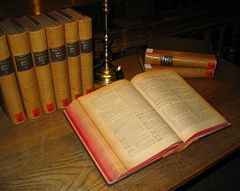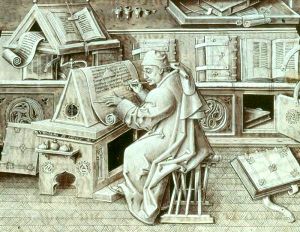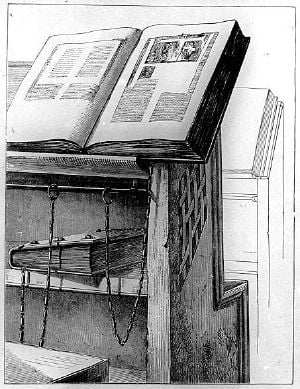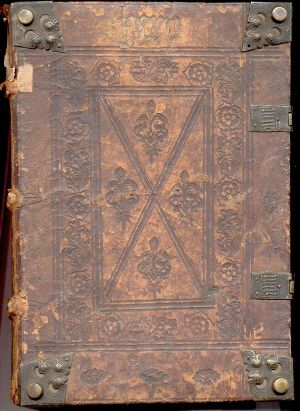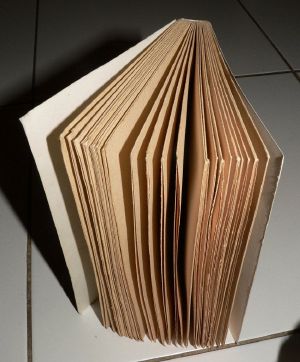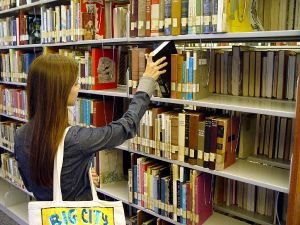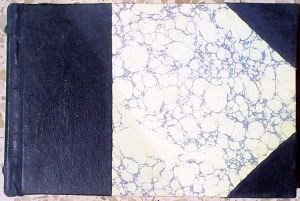Book
A book is a set or collection of written, printed, illustrated, or blank sheets, made of paper, parchment, or other material, usually fastened together to hinge at one side, and within protective covers. A single sheet within a book is called a leaf, and each side of a sheet is called a page. In today's world, books that are produced electronically are called e-books, challenging the notion of a book as simply a materially-bound collection of pages.
The term 'book' may also refer to a literary work, or a main division of such a work. In library and information science, a book is called a monograph, to distinguish it from serial periodicals such as magazines, journals or newspapers. A lover of books is usually referred to as a bibliophile, a bibliophilist, or a philobiblist, or, more informally, a bookworm.
Books play a major role in the preservation of culture and tradition and the concept of printed words as scripture occupies a central role in various faith traditions.
History of books
Antiquity
When writing systems were invented in ancient civilizations, nearly everything that could be written upon—stone, clay, tree bark, metal sheets—was used for writing. Alphabetic writing emerged in Egypt around 1800 B.C.E. At first the words were not separated from each other (scripta continua) and there was no punctuation. Texts were written from right to left, left to right, and even so that alternate lines read in opposite directions.
Scroll
Papyrus, a form of paper made by weaving the stems of the papyrus plant, then pounding the woven sheet with a hammer-like tool, was used for writing in Ancient Egypt, perhaps as early as the First Dynasty, although the first evidence is from the account books of King Neferirkare Kakai of the Fifth Dynasty (about 2400 B.C.E.).[1] Papyrus sheets were glued together to form a scroll. Tree bark such as lime (Latin liber, from there also library) and other materials were also used.[2]
According to Herodotus (History 5:58), the Phoenicians brought writing and papyrus to Greece around the tenth or ninth century B.C.E. The Greek word for papyrus as writing material (biblion) and book (biblos) come from the Phoenician port town Byblos, through which papyrus was exported to Greece.[3]
Whether made from papyrus, parchment, or paper in East Asia, scrolls were the dominant form of book in the Hellenistic, Roman, Chinese and Hebrew cultures. The codex form took over the Roman world by late antiquity, but lasted much longer in Asia.
Codex
Papyrus scrolls were still dominant in the first century AD, as witnessed by the findings in Pompeii. The first written mention of the codex as a form of book is from Martial, in his Apophoreta CLXXXIV at the end of the century, where he praises its compactness. However the codex never gained much popularity in the pagan Hellenistic world, and only within the Christian community did it gain widespread use.[4] This change happened gradually during the third and fourth centuries, and the reasons for adopting the codex form of the book are several: the format is more economical, as both sides of the writing material can be used; and it is portable, searchable, and easy to conceal. The Christian authors may also have wanted to distinguish their writings from the pagan texts written on scrolls.
Wax tablets were the normal writing material in schools, in accounting, and for taking notes. They had the advantage of being reusable: the wax could be melted, and reformed into a blank. The custom of binding several wax tablets together (Roman pugillares) is a possible precursor for modern books (i.e. codex).[5]The etymology of the word codex (block of wood) also suggests that it may have developed from wooden wax tablets.[6]
In the fifth century, Isidore of Seville explained the relation between codex, book and scroll in his Etymologiae (VI.13): "A codex is composed of many books; a book is of one scroll. It is called codex by way of metaphor from the trunks (codex) of trees or vines, as if it were a wooden stock, because it contains in itself a multitude of books, as it were of branches."
Middle Ages
Manuscripts
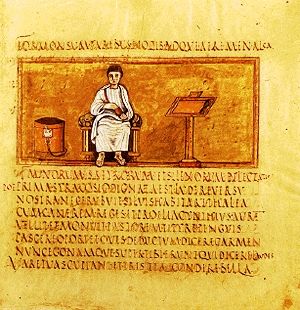
The fall of the Roman Empire in the fifth century C.E. saw the decline of the culture of ancient Rome. Papyrus became difficult to obtain, due to lack of contact with Egypt, and parchment, which had been used for centuries, began to be the main writing material.
Monasteries carried on the Latin writing tradition in the Western Roman Empire. Cassiodorus, in the monastery of Vivarium (established around 540), stressed the importance of copying texts[7]. St. Benedict of Nursia, in his Regula Monachorum (completed around the middle of the 6th century) later also promoted reading.[8] The Rule of Saint Benedict (Ch. XLVIII), which set aside certain times for reading, greatly influenced the monastic culture of the Middle Ages, and is one of the reasons why the clergy were the predominant readers of books. The tradition and style of the Roman Empire still dominated, but slowly the peculiar medieval book culture emerged.
Before the invention and adoption of the printing press, almost all books were copied by hand, making books expensive and comparatively rare. Smaller monasteries usually had only some dozen books, medium sized perhaps a couple hundred. By the ninth century, larger collections held around 500 volumes; and even at the end of the Middle Ages, the papal library in Avignon and Paris library of Sorbonne held only around 2,000 volumes.[9]
The scriptorium of the monastery was usually located over the chapter house. Artificial light was forbidden, for fear it may damage the manuscripts. There were five types of scribes:
- Copyists, who dealt with basic production and correspondence
- Calligraphers, who dealt in fine book production
- Correctors, who collated and compared a finished book with the manuscript from which it had been produced
- Rubricators, who painted in the red letters
- Illuminators, who painted illustrations
The bookmaking process was long and laborious. The parchment had to be prepared, then the unbound pages were planned and ruled with a blunt tool or lead, after which the text was written by the scribe, who usually left blank areas for illustration and rubrication. Finally the book was bound by the bookbinder.[10]
Different types of ink were known in antiquity, usually prepared from soot and gum, and later also from gall nuts and iron vitriol. This gave writing the typical brownish black color, but black or brown were not the only colours used. There are texts written in red or even gold, and different colours were used for illumination. Sometimes the whole parchment was coloured purple, and the text was written on it with gold or silver (eg Codex Argenteus).[11]
Irish monks introduced spacing between words in the seventh century. This facilitated reading, as these monks tended to be less familiar with Latin. However the use of spaces between words did not become commonplace before the 12th century. It has been argued,[12] that the use of spacing between words shows the transition from semi-vocalized reading into silent reading.
The first books used parchment or vellum (calf skin) for the pages. The book covers were made of wood and covered with leather. As dried parchment tends to assume the form before processing, the books were fitted with clasps or straps. During the later Middle Ages, when public libraries appeared, books were often chained to a bookshelf or a desk to prevent theft. The so called libri catenati were used up to eighteenth century.
At first books were copied mostly in monasteries, one at a time. With the rise of universities in the thirteenth century, the Manuscript culture of the time lead to an increase in the demand for books, and a new system for copying books appeared. The books were divided into unbound leaves (pecia), which were lent out to different copyists, so the speed of book production was considerably increased. The system was maintained by stationers guilds, which were secular, and produced both religious and non-religious material.[13]
Wood block printing
In woodblock printing, a relief image of an entire page was carved into blocks of wood, inked, and used to print copies of that page. This method originated in China, in the Han dynasty (before 220 C.E.), as a method of printing on textiles and later paper, and was widely used throughout East Asia. The oldest dated book printed by this method is The Diamond Sutra (868 C.E.).
The method (called Woodcut when used in art) arrived in Europe in the early fourteenth century. Books (known as block-books), as well as playing-cards and religious pictures, began to be produced by this method. Creating an entire book was a painstaking process, requiring a hand-carved block for each page; and the wood blocks tended to crack, if stored for long.
Movable type and incunabula
The Chinese inventor Pi Sheng made movable type of earthenware circa 1045, but there are no known surviving examples of his printing. Metal movable type was invented in Korea during the Goryeo Dynasty (around 1230), but was not widely used: one reason being the enormous Chinese character set. Around 1450, in what is commonly regarded as an independent invention, Johannes Gutenberg introduced movable type in Europe, along with innovations in casting the type based on a matrix and hand mould. This invention gradually made books less expensive to produce, and more widely available.
Early printed books, single sheets and images which were created before the year 1501 in Europe are known as incunabula. A man born in 1453, the year of the fall of Constantinople, could look back from his fiftieth year on a lifetime in which about eight million books had been printed, more perhaps than all the scribes of Europe had produced since Constantine founded his city in A.D. 330.[14]
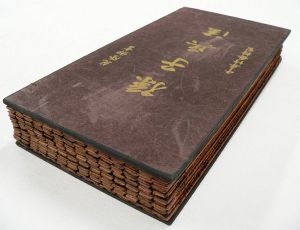
Books in the Orient
China
Writing on bone, shells, wood, and silk existed in China by the second century B.C.E.. Paper was invented in China around the first century.
The discovery of the process using the bark of the blackberry bush is attributed to Ts'ai Louen, but it may be older. Texts were reproduced by woodblock printing; the diffusion of Buddhist texts was a main impetus to large-scale production. In the eleventh century, a blacksmith, Pi Cheng, invented movable type, but woodblock printing remained the main technique for books, possibly because of the poor quality of the ink. The Uyghurs of Turkistan also used movable type, as did the Koreans and Japanese.
The format of the book evolved in China in a similar way to that in Europe, but much more slowly, and with intermediate stages of scrolls folded concertina-style, scrolls bound at one edge ("butterfly books") and so on. Printing was nearly always on one side of the paper only.
Modern world
Steam-powered printing presses became popular in the early 1800s. These machines could print 1,100 sheets per hour, but workers could only set 2,000 letters per hour.
Monotype and linotype presses were introduced in the late nineteenth century. They could set more than 6,000 letters per hour and an entire line of type at once.
The centuries after the fifteenth century were thus spent on improving both the printing press and the conditions for freedom of the press through the gradual relaxation of restrictive censorship laws. See also intellectual property, public domain, copyright. In mid-twentieth century, European book production had risen to over 200,000 titles per year.
Book structure
The common structural parts of a book include:
- Front cover: hardbound or softcover (paperback); the spine is the binding that joins the front and rear covers where the pages hinge
- Front endpaper
- Flyleaf
- Front matter
- Frontispiece
- Title page
- Copyright page: typically verso of title page: shows copyright owner/date, credits, edition/printing, cataloging details
- Table of contents
- List of figures
- List of tables
- Dedication
- Acknowledgments
- Foreword
- Preface
- Introduction
- Body: the text or contents, the pages often collected or folded into signatures; the pages are usually numbered sequentially, and often divided into chapters.
- Back matter
- Appendix
- Glossary
- Index
- Notes
- Bibliography
- Colophon
- Flyleaf
- Rear endpaper
- Rear cover
Sizes
The size of a modern book is based on the printing area of a common flatbed press. The pages of type were arranged and clamped in a frame, so that when printed on a sheet of paper the full size of the press, the pages would be right side up and in order when the sheet was folded, and the folded edges trimmed.
The most common book sizes are:
- Quarto (4to): the sheet of paper is folded twice, forming four leaves (eight pages) approximately 11-13 inches (ca 30 cm) tall
- Octavo (8vo): the most common size for current hardcover books. The sheet is folded three times into eight leaves (16 pages) up to 9 ¾" (ca 23 cm) tall.
- DuoDecimo (12mo): a size between 8vo and 16mo, up to 7 ¾" (ca 18 cm) tall
- Sextodecimo (16mo): the sheet is folded four times, forming sixteen leaves (32 pages) up to 6 ¾" (ca 15 cm) tall
Sizes larger than quarto are:
- Folio: up to 15" (ca 38 cm) tall.
- Elephant Folio: up to 23" (ca 58 cm) tall.
- Atlas Folio: up to 25" (ca 63 cm) tall.
- Double Elephant Folio: up to 50" (ca 127 cm) tall.
Sizes smaller than 16mo are:
- 24mo: up to 5 ¾" (ca 13 cm) tall.
- 32mo: up to 5" (ca 12 cm) tall.
- 48mo: up to 4" (ca 10 cm) tall.
- 64mo: up to 3" (ca 8 cm) tall.
Types of books
Small books can be called booklets.
Notebooks are blank books to be written in by the user. Students use them for taking notes. Scientists and other researchers use lab notebooks to record their work. Many notebooks are simply bound by a spiral coil at the edge so that pages can be easily torn out. Books to be partly filled in by the user include a personal address book, phone book, or calendar book for recording appointments, etc.
Albums are books for holding collections of memorabilia, pictures or photographs. They are often made so that the pages are removable. albums hold collections of stamps.
Books for recording periodic entries by the user, such as daily information about a journey, are called logbooks or simply logs. A similar book for writing daily the owner's private personal events and information is called a diary.
Businesses use accounting books such as journals and ledgers to record financial data in a practice called bookkeeping.
Pre-printed school books for students to study are commonly called textbooks. Elementary school pupils often use workbooks which are published with spaces or blanks to be filled by them for study or homework.
A book with written prayers is called a prayerbook or missal. A book with a collection of hymns is called a hymnal.
In a library, a general type of non-fiction book which provides information as opposed to telling a story, essay, commentary, or otherwise supporting a point of view, is often referred to as a reference book. A very general reference book, usually one-volume, with lists of data and information on many topics is called an almanac. A more specific reference book with tables or lists of data and information about a certain topic, often intended for professional use, is often called a handbook. Books with technical information on how to do something or how to use some equipment are called manuals.
An encyclopedia is a book or set of books with articles on many topics. A book listing words, their etymology, meanings, etc. is called a dictionary. A book which is a collection of maps is an atlas. Books which try to list references and abstracts in a certain broad area may be called an index, such as Engineering Index, or abstracts such as Chemical Abstracts, Biological Abstracts, etc.
Bookmarks were used throughout the medieval period,[15] consisting usually of a small parchment strip attached to the edge of folio (or a piece of cord attached to headband). Bookmarks in the eighteenth and nineteenth centuries were narrow silk ribbons bound into the book and become widespread in the 1850s. They were usually made from silk, embroidered fabrics or leather. Not until the 1880s, did paper and other materials become more common.
A book may be studied by students in the form of a book report. It may also be covered by a professional writer as a book review to introduce a new book. Some belong to a book club.
Books may also be categorized by their binding or cover. Hard cover books have a stiff binding. Paperback books have cheaper, flexible covers which tend to be less durable.
Publishing is a process for producing books, magazines, newspapers, etc. pre-printed for the reader/user to buy, usually in large numbers by a publishing company. Such books can be categorized as fiction (made-up stories) or non-fiction (information written as true). A book-length fiction story is called a novel.
Publishers may produce low-cost, pre-publication copies known as galleys or 'bound proofs' for promotional purposes, such as generating reviews in advance of publication. Galleys are usually made as cheaply as possible, since they are not intended for sale.
Collections of books
Private or personal libraries made up of non-fiction and fiction books, (as opposed to the state or institutional records kept in archives) first appeared in classical Greece. In ancient world the maintaining of a library was usually (but not exclusively) the privilege of a wealthy individual. These libraries could have been either private or public, i.e. for individuals that were interested in using them. The difference from a modern public library lies in the fact that they were usually not funded from public sources. It is estimated that in the city of Rome at the end of the third century there were around 30 public libraries, public libraries also existed in other cities of the ancient Mediterranean region (e.g., Library of Alexandria).[16] Later, in the Middle Ages, monasteries and universities had also libraries that could be accessible to general public. Typically not the whole collection was available to public, the books could not be borrowed and often were chained to reading stands to prevent theft.
The beginning of modern public library begins around 15th century when individuals started to donate books to towns.[17] The growth of a public library system in the United States started in the late nineteenth century and was much helped by donations from Andrew Carnegie. This reflected classes in a society: The poor or the middle class had to access most books through a public library or by other means while the rich could afford to have a private library built in their homes.
The advent of paperback books in the 20th century led to an explosion of popular publishing. Paperback books made owning books affordable for many people. Paperback books often included works from genres that had previously been published mostly in pulp magazines. As a result of the low cost of such books and the spread of bookstores filled with them (in addition to the creation of a smaller market of extremely cheap used paperbacks) owning a private library ceased to be a status symbol for the rich.
In library and booksellers' catalogues, it is common to include an abbreviation such as "Crown 8vo" to indicate the paper size from which the book is made.
When rows of books are lined on a bookshelf, bookends are sometimes needed to keep them from slanting.
Identification and classification
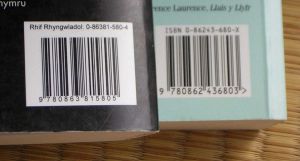
During the twentieth century, librarians were concerned about keeping track of the many books being added yearly to the Gutenberg Galaxy. Through a global society called the International Federation of Library Associations and Institutions (IFLA), they devised a series of tools including the International Standard Book Description or ISBD.
Each book is specified by an International Standard Book Number, or ISBN, which is unique to every edition of every book produced by participating publishers, world wide. It is managed by the ISBN Society. An ISBN has four parts: the first part is the country code, the second the publisher code, and the third the title code. The last part is a check digit, and can take values from 0–9 and X (10). The EAN Barcodes numbers for books are derived from the ISBN by prefixing 978, for Bookland, and calculating a new check digit.
Commercial publishers in industrialized countries generally assign ISBNs to their books, so buyers may presume that the ISBN is part of a total international system, with no exceptions. However many government publishers, in industrial as well as developing countries, do not participate fully in the ISBN system, and publish books which do not have ISBNs.
A large or public collection requires a catalogue. Codes called "call numbers" relate the books to the catalogue, and determine their locations on the shelves. Call numbers are based on a Library classification system. The call number is placed on the spine of the book, normally a short distance before the bottom, and inside.
Institutional or national standards, such as ANSI/NISO Z39.41 - 1997, establish the correct way to place information (such as the title, or the name of the author) on book spines, and on "shelvable" book-like objects, such as containers for DVDs, video tapes and software.
One of the earliest and most widely known systems of cataloguing books is the Dewey Decimal System. This system has fallen out of use in some places, mainly because of a Eurocentric bias and other difficulties applying the system to modern libraries. However, it is still used by most public libraries in America. The Library of Congress Classification system is more popular in academic libraries.
Classification systems
- Dewey Decimal Classification (DDC)
- Library of Congress Classification (LCC)
- Chinese Library Classification (CLC)
- Universal Decimal Classification (UDC)
- Harvard-Yenching Classification
Transition to digital format
The term e-book (electronic book) in the broad sense is an amount of information like a conventional book, but in digital form. It is made available through internet, CD-ROM, etc. In the popular press the term e-Book sometimes refers to a device such as the Sony Librie EBR-1000EP, which is meant to read the digital form and present it in a human readable form.
Throughout the twentieth century, libraries have faced an ever-increasing rate of publishing, sometimes called an information explosion. The advent of electronic publishing and the Internet means that much new information is not printed in paper books, but is made available online through a digital library, on CD-ROM, or in the form of e-books.
On the other hand, though books are nowadays produced using a digital version of the content, for most books such a version is not available to the public (i.e., neither in the library nor on the Internet), and there is no decline in the rate of paper publishing. There is an effort, however, to convert books that are in the public domain into a digital medium for unlimited redistribution and infinite availability. The effort is spearheaded by Project Gutenberg combined with Distributed Proofreaders.
There have also been new developments in the process of publishing books. Technologies such as print on demand have made it easier for less known authors to make their work available to a larger audience.
Paper and conservation issues
Though papermaking in Europe had begun around the eleventh century, up until the beginning of sixteenth century vellum and paper were produced congruent to one another, vellum being the more expensive and durable option. Printers or publishers would often issue the same publication on both materials, to cater to more than one market.
Paper was first made in China, as early as 200 B.C.E., and reached Europe through Muslim territories. At first made of rags, the industrial revolution changed paper-making practices, allowing for paper to be made out of wood pulp.
Paper made from wood pulp was introduced in the early-nineteenth century, because it was cheaper than linen or abaca cloth-based papers. Pulp-based paper made books less expensive to the general public. This paved the way for huge leaps in the rate of literacy in industrialised nations, and enabled the spread of information during the Second Industrial Revolution.
However pulp paper contained acid, that eventually destroys the paper from within. Earlier techniques for making paper used limestone rollers, which neutralized the acid in the pulp. Books printed between 1850 and 1950 are at risk; more recent books are often printed on acid-free or alkaline paper. Libraries today have to consider mass deacidification of their older collections.
The proper care of books takes into account the possibility of physical and chemical damage to the cover and text. Books are best stored out of direct sunlight, in reduced lighting, at cool temperatures, and at moderate humidity. They need the support of surrounding volumes to maintain their shape, so it is desirable to shelve them by size.
See also
- Literature
- Library
Notes
- ↑ Leila Avrin. Scribes, script, and books: the book arts from antiquity to the Renaissance. (Chicago; London: American Library Association; The British Library, 1991. ISBN: 9780838905227), 83
- ↑ Dard Hunter. Papermaking: History and Technique of an Ancient Craft, New ed. (New York: Dover Publications, 1978), 12.
- ↑ Leila Avrin. Scribes, Script and Books, 144–145.
- ↑ The Cambridge History of Early Christian Literature. Eds. Frances Young, Lewis Ayres, Andrew Louth. (Cambridge University Press, 2004), 8–9.
- ↑ Leila Avrin. Scribes, Script and Books, p. 173.
- ↑ Bernhard Bischoff. Latin palaeography antiquity and the Middle Ages, translated by David Ganz and Dáibhí ó Cróinin. (Cambridge, UK: Cambridge University Press, 1990. ISBN: 0521364736), 11
- ↑ Leila Avrin. Scribes, Script and Books, 207–208.
- ↑ Theodore Maynard. Saint Benedict and His Monks. (Staples Press Ltd. 1956), 70–71.
- ↑ Martin D. Joachim. Historical Aspects of Cataloging and Classification. (Haworth Press, 2003), 452.
- ↑ Edith Diehl. Bookbinding: Its Background and Technique. (Mineola, New York: Dover Publications, 1980), 14–16.
- ↑ Bernhard Bischoff. Latin Palaeography, 16–17.
- ↑ Paul Saenger. Space Between Words: The Origins of Silent Reading. (Stanford University Press, 1997).
- ↑ Bernhard Bischoff. Latin Palaeography, 42–43.
- ↑ Michael Clapham, "Printing" in A History of Technology, Vol 2. From the Renaissance to the Industrial Revolution, ed. Charles Singer et al. (Oxford 1957), 377. Cited from Elizabeth L. Eisenstein, The Printing Press as an Agent of Change (Cambridge University, 1980).
- ↑ For a ninth century Carolingian bookmark see: J. A. Szirmai. The archaeology of medieval bookbinding. (Aldershot, UK: Ashgate, 1999. ISBN 0859679047), 123. For a fifteenth century bookmark see Medeltidshandskrift 34, (Lund University Library).
- ↑ Miriam A. Drake. Encyclopedia of Library and Information Science. (Marcel Dekker, 2003), "Public Libraries, History".
- ↑ Miriam A. Drake, Encyclopedia of Library, "Public Libraries, History".
ReferencesISBN links support NWE through referral fees
- Avrin, Leila. Scribes, script, and books: the book arts from antiquity to the Renaissance. Chicago; London: American Library Association; The British Library, 1991. ISBN 978-0838905227
- Bischoff, Bernhard. Latin palaeography antiquity and the Middle Ages. Cambridge: Cambridge University Press, 1990. ISBN 0521364736
- Diehl, Edith. Bookbinding: Its Background and Technique, reprint ed. Mineola, NY: Dover Publications, 1980 (original 1946). ASIN B00126P58I B00126P58I
- Eisenstein, Elizabeth L. The Printing Press as an Agent of Change. in 2 vols. Cambridge: Cambridge University Press, 1979. ISBN 0521220440
- Hunter, Dard. Papermaking: History and Technique of an Ancient Craft. reprint ed. Dover Publications, 1987 (original 1943).
- Joachim, Martin D. Historical Aspects of Cataloging and Classification. Haworth Press, 2003.
- Maynard, Theodore. Saint Benedict and His Monks. London: Staples Press Ltd, 1956.
- Saenger, Paul. Space Between Words: The Origins of Silent Reading. Stanford University Press, 2000 (original 1997). ISBN 0804726531
- Szirmai, J. A. The archeology of medieval bookbinding. Aldershot: Ashgate, 1999. ISBN 0859679047
- Young, Frances, Lewis Ayres, and Andrew Louth, (eds.). The Cambridge History of Early Christian Literature. Cambridge University Press, 2007. ISBN 0521697506
External links
All links retrieved November 17, 2023.
- Information on Old Books Smithsonian Institution Libraries.
- Society for the History of Authorship, Reading and Publishing.
Credits
New World Encyclopedia writers and editors rewrote and completed the Wikipedia article in accordance with New World Encyclopedia standards. This article abides by terms of the Creative Commons CC-by-sa 3.0 License (CC-by-sa), which may be used and disseminated with proper attribution. Credit is due under the terms of this license that can reference both the New World Encyclopedia contributors and the selfless volunteer contributors of the Wikimedia Foundation. To cite this article click here for a list of acceptable citing formats.The history of earlier contributions by wikipedians is accessible to researchers here:
The history of this article since it was imported to New World Encyclopedia:
Note: Some restrictions may apply to use of individual images which are separately licensed.
